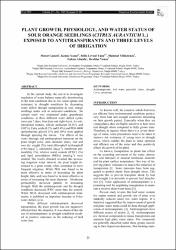PLANT GROWTH, PHYSIOLOGY, AND WATER STATUS OF SOUR ORANGE SEEDLINGS (CITRUS AURANTIUM L.) EXPOSED TO ANTITRANSPIRANTS AND THREE LEVELS OF IRRIGATION

View/
Date
2018Author
Güneri, MuratYazar, Kemal
Tuna, Atilla Levent
Yıldıztekin, Mahmut
Altunlu, Hakan
Yokaş, İbrahim
Metadata
Show full item recordAbstract
In the current study, the aim is to investigate regulation of water balance especially deteriorating in the heat conditions due to low water uptake and resistance to drought conditions by decreasing water deficit through transpiration in sour orange seedlings under arid or semi-arid conditions. The current study was conducted under greenhouse conditions, at three different water deficit cycles (once per 2 days, four days and eight days). As antitranspirant matters, silicon surfactant (0.01% and 0.02%), Fatty acids (0.2% and 0.4%) and PEG 6000 (polyethylene glycol) (5% and 10%) were applied through spraying the leaves. The effects of the water shortage and antitranspirant treatment on the plant height (cm), stem diameter (mm), leaf and root dry weight (%), total chlorophyll (chlorophyll a+b) (mg.g(-1)), carotenoid (mg.g(-1)), membrane permeability (%), relative water content (RWC) (%) and lipid peroxidation (MDA) (nmol.g(-1)) were studied. The results obtained revealed that increasing irrigation water interval, the plant height decreased to a great extent, when compared to more frequent irrigation. While PEG was found to be more effective in terms of increasing the plant height, fatty acid was found to be more effective in terms of increasing the stem diameter. Membrane permeability increased parallel to increasing drought. Both the antitranspirants and the drought conditions decreased RWC more than the control. While MDA decreased with antitranspirant treatments, it exhibited an important increase in 8-day water deficit cycle. While different antitranspirants decreased transpiration, the plant growth was not negatively affected from this situation. It was observed that the use of antitranspirants in drought conditions resulted in positive outcomes in the reducing of leaf water loss.

















